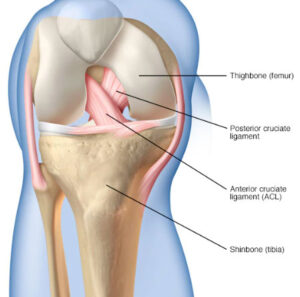
What Leads to PCL Injuries?
PCL injuries primarily stem from trauma, such as the forceful impact of a bent knee against a car dashboard in an auto accident, or a football player falling on a bent knee. Sports-related incidents like hyperextension and twisting motions can also cause these injuries. Knee dislocation often accompanies a PCL injury, although such injuries can develop gradually.
What Are the Symptoms of PCL Injury? 
- Symptoms typically include immediate knee pain and swelling, accompanied by a sensation of instability while standing or walking.
- Pain, predominantly felt at the back of the knee, worsens during kneeling.
- Additionally, discomfort in the front of the knee may emerge within a week or two following the injury, particularly noticeable when attempting to accelerate or decelerate.
How is a PCL Injury Diagnosed?
Diagnosing a PCL injury presents challenges as this ligament is situated deep within the knee joint and often occurs alongside injuries to other knee structures. Hence, a comprehensive differential diagnosis is crucial.
Physical examination alone may not suffice to diagnose PCL injuries, necessitating imaging studies to rule out other knee injuries and confirm the diagnosis. Additionally, doctors may suggest arthroscopy to visualize the tears and assess the extent of damage directly
Non-Surgical Treatment
Mild to moderate PCL tears often respond well to non-surgical treatment methods, which may include:
- Cold Therapy: Resting the knee and applying ice packs as advised by the doctor. Gentle compression and elevating the knee may also be recommended to expedite healing.
- Immobilization: Utilizing a knee brace to restrict knee movement and using crutches to avoid bearing weight on the affected leg.
- Physical Therapy: Initiated once if swelling subsides, physical therapy sessions prescribed by the doctor aim to restore knee function and strengthen supporting muscles, particularly the quadriceps.
PCL Injury Ligament Reconstruction
Surgery may become necessary if a PCL injury leads to a bone fragment being torn off along with the ligament tear itself.
Additionally, severe PCL injuries, those involving other knee ligaments, or cases where athletes experience chronic symptoms due to loose ligaments may also warrant surgical intervention.
The procedure aims to reconstruct the damaged ligament, as simply suturing the torn ends together typically doesn’t promote healing. Instead, the torn ligament is replaced with a tissue graft either from another part of the patient’s body or a donor.
Arthroscopic surgery is commonly utilized due to its minimally invasive nature. Recovery duration varies depending on the severity of the injury and may range from 6 to 12 months for complete rehabilitation.
Multi-ligament injuries
Introduction
Multi-ligament injuries in the knee pose complex orthopedic challenges, often arising from traumatic incidents like sports mishaps. These injuries involve simultaneous damage to multiple knee ligaments, resulting in considerable instability and functional impairment. Prompt identification and appropriate management are essential to mitigate long-term complications and restore knee function. Multi-ligament reconstruction surgery offers a specialized approach to address these injuries, focusing on restoring ligament integrity and enhancing joint stability for improved patient outcomes.
Types of Multi-Ligament Injury
Multi-ligament injuries encompass various types due to the extensive array of ligaments and other associated structures susceptible to damage. Certain ligaments are commonly affected in conjunction with other structures, including:
- O’Donoghue’s triad- also known as the unhappy triad, involves injury to the anterior cruciate ligament, medial collateral ligament, and meniscus.
- Dislocated knee– characterized by severe rupture affecting most ligaments within the knee.
- Postero-lateral rotatory instability injury- It entails damage to structures located towards the posterior and lateral aspects of the knee, such as the posterior cruciate ligament, lateral collateral ligament, and popliteus muscle.
Procedure
In Multiligament Knee Reconstruction surgery, ligaments are reconstructed using tissue either from the patient’s own body (autograft) or from a donor (allograft).
Typically, surgical reconstruction is conducted arthroscopically through small incisions, employing an arthroscope and miniature surgical instruments. The surgeon drills small tunnels in the thigh and tibia bones, through which the grafts are inserted to substitute the injured ligaments.
Subsequently, fixation devices are employed to secure the grafts and maintain ligament stability until the healing process ensues.
